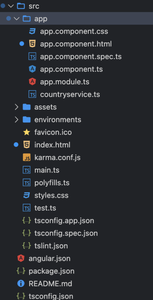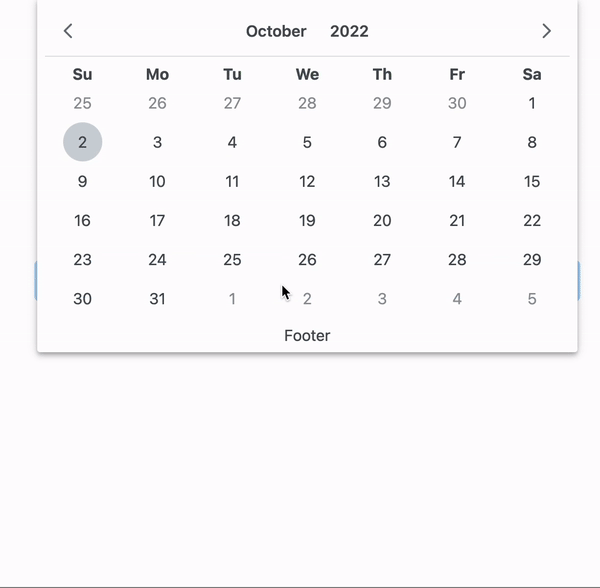Angular PrimeNG表格日历模板组件
Angular PrimeNG是一个开源框架,拥有丰富的原生Angular UI组件,可用于出色的造型,这个框架用于制作响应式网站,非常方便。本文将向我们展示如何使用Angular PrimeNG 表格日历模板组件。
日历组件用于显示一个按月划分的日历,允许用户选择日期并移动到下个月或上个月。
Angular PrimeNG表格日历模板:
- header。它用于定义页眉。
- footer。它用于定义页脚。
- decade: $implicit 它是一个数组,包含十年的开始和年份,显示在年份选择器的头部。
- date。$implicit 它是一个组件的值。
语法:
<p-calendar [(ngModel)]="...">
<ng-template pTemplate="header">
...
</ng-template>
</p-calendar>
创建Angular应用程序和模块安装。
第1步:使用以下命令创建一个Angular应用程序。
ng new appname
第2步:创建你的项目文件夹即appname后,使用以下命令移动到它。
cd appname
第3步:在你给定的目录中安装PrimeNG。
npm install primeng --save
npm install primeicons --save
项目结构:它将看起来像如下。

Project Structure
示例1:在下面的代码中,我们将利用上述模板来演示日历组件的标题模板的使用。
- app.component.html:
<div style="text-align:center;">
<h1 style="color:green;">GeeksforGeeks</h1>
<h3>A computer science portal for geeks</h3>
<h4>Angular PrimeNG Form
Calendar Templates Component
</h4>
<h5>Template: "Header"</h5>
<div class="p-fluid p-grid p-formgrid">
<div class="p-field p-col-4 p-md-4">
<label for="basic">GfG</label>
<p-calendar [(ngModel)]="date1">
<ng-template
pTemplate="header">
Header
</ng-template>
</p-calendar>
</div>
</div>
</div>
- app.component.ts:
import { Component } from '@angular/core';
@Component({
selector: 'app-root',
templateUrl: './app.component.html'
})
export class AppComponent {
date1?: Date;
}
- app.module.ts:
import { NgModule } from '@angular/core';
import { BrowserModule } from '@angular/platform-browser';
import { FormsModule } from '@angular/forms';
import { BrowserAnimationsModule }
from '@angular/platform-browser/animations';
import { AppComponent } from './app.component';
import { CalendarModule } from 'primeng/calendar';
@NgModule({
imports: [
BrowserModule,
BrowserAnimationsModule,
CalendarModule,
FormsModule
],
declarations: [AppComponent],
bootstrap: [AppComponent]
})
export class AppModule { }
输出:

示例2:在下面的代码中,我们将利用上述模板来演示日历组件的页脚模板的使用。
- app.component.html:
<div style="text-align:center;">
<h1 style="color:green;">GeeksforGeeks</h1>
<h3>A computer science portal for geeks</h3>
<h4>Angular PrimeNG Form
Calendar Templates Component
</h4>
<h5>Template: "Footer"</h5>
<div class="p-fluid p-grid p-formgrid">
<div class="p-field p-col-4 p-md-4">
<label for="basic">GfG</label>
<p-calendar [(ngModel)]="date1">
<ng-template
pTemplate="footer">
Footer
</ng-template>
</p-calendar>
</div>
</div>
</div>
- app.component.ts:
import { Component } from '@angular/core';
@Component({
selector: 'app-root',
templateUrl: './app.component.html'
})
export class AppComponent {
date1?: Date;
}
- app.module.ts:
import { NgModule } from '@angular/core';
import { BrowserModule } from '@angular/platform-browser';
import { FormsModule } from '@angular/forms';
import { BrowserAnimationsModule }
from '@angular/platform-browser/animations';
import { AppComponent } from './app.component';
import { CalendarModule } from 'primeng/calendar';
@NgModule({
imports: [
BrowserModule,
BrowserAnimationsModule,
CalendarModule,
FormsModule
],
declarations: [AppComponent],
bootstrap: [AppComponent]
})
export class AppModule { }
输出:

 极客教程
极客教程